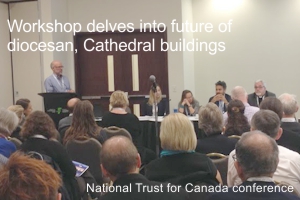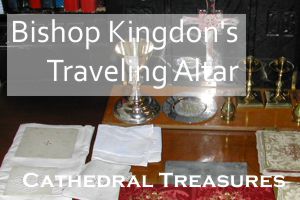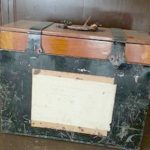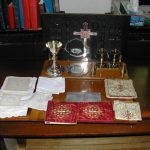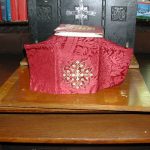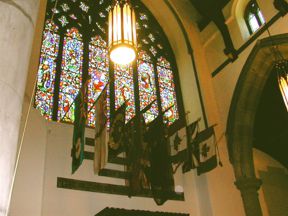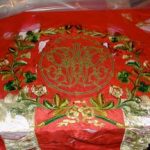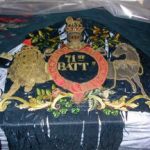Workshop delves into future of diocesan, Cathedral buildings
About 40 people gathered on Oct. 18 for an investigative tour and thinking session as part of the National Trust's annual conference, held in Fredericton this year.The National Trust is a registered charity established in 1973 by the Government of Canada, dedicated to promoting the conservation,...
Category Archives: Cathedral Building
Bishop Kingdon’s Traveling Altar – Cathedral Treasures
Hollingworth Tully Kingdon was Bishop Coadjutor (1881-1892) and Second Bishop of Fredericton (1892 – 1907).
One of the artifacts identified in preparing the inventory of the Cathedral Vault in 2004 was Bishop Kingdon’s “traveling altar.” It could be called “portable” except that it is a significant weight when folded up. Once set up it is intriguing. It would have been used by him or perhaps other traveling clergy in situations in the Diocese where there was no church and was probably used in a private residence or a (church or community) hall. Photo 1 (by Nathan Cutler) shows the entire altar “boxed up” and in its metal case.
There was a metal top to the case and all is held in place by a leather strap. In the photo, is it difficult to read on the side but on the large piece of white paper it has the bishop’s name and simply “Fredericton.” The City of Fredericton at that time was still small enough that even the street address was probably not needed.
Photo 2 shows it all unfolded, although not set up for eucharist. Photo 3 displays the chalice and paten covered (in this case) by the veil and pall.
The box that is formed by the altar itself opens up in a forward direction so that the section seen whereon the chalice and paten are resting is the bottom and the area whereon the red and white veils and palls are sitting would be the front of the box. Notice the altar cross is built into the wood of the back. During this time the priest would have presided in an “eastward celebration” (with his back to the congregation). There are two candlesticks with the original candles in a metal box that also folds into the set as well as two small vases. Original flowers not found! The grey area underneath the red veil and pall is the altar stone.
The many pieces of white linen include purificators, veils and corporals and there is also an actual “fair linen” (table cloth) which would have covered the altar itself as seen on the altars in churches of modern times.
[Hollingworth Tully Kingdon, John Medley’s hand-picked successor, had spent some eleven years standing in the shadow of the aged metropolitan. He was often excluded from the full exercise of his office—largely, in Kingdon’s own view, as a result of the interference of Mrs. Medley, who was so jealous of her husband’s prerogatives that Kingdon was to describe her as “a regular Mrs. Proudie with a vengeance.” During her husband’s declining years, Margaret Medley had denied Kingdon access to diocesan correspondence and, it appears, attempted to administer the diocese with no reference whatever to the coadjutor. For a man described as possessing “marked executive ability” who insisted that “…all the business of the Church must be transacted in legal and business-like methods,” this situation must have seemed intolerable. Reference has already been made to the troubled relationship between the Medleys and Bishop Kingdon. Kingdon had discouraged attempts to force Medley’s resignation, as “…the attempt would only make my position more unbearable, as it would increase the suspicious jealousy which exists.” Consequently, he wrote to his friend Bishop Blyth of Jerusalem, “I am afraid that the Church is not thriving here so well as I hoped, or so well as I could wish—it is terribly uphill work.”] from “Citizens with the Saints,” Lyman N. Harding 1994.Hank Williams
Cathedral Verger
History in colours – Cathedral Treasures
As you walk out the west door have you ever stopped to look up over the door to notice the military colours hanging above? There is a very old tradition that when a military regiment receives a new colour, the old one, which has been blessed, cannot be destroyed. It is therefore put up in a chapel, church or cathedral to continue to “fly.” With the RCR just down the road many of the colours we have are from them. The photo was taken of the flags and colours which were then in the cathedral during the inventory of 2004. Anyone with a military background is welcome to comment with additional information.
In the photo, the flags go from left to right: the RCAF flag (pre-1965 as there is no Maple Leaf on it), followed by an ensign which flew on the HMCS Chaleur which was a mine sweeper dating from the early 1960’s. The third is a colour for the RCR, followed by two very old colours. The next three on the other side are also from the RCR. A few years ago we were requested to return two of them to the RCR museum in London, Ontario. In so doing we rearranged the ones left as they are now.
The two oldest ones are made of silk, red and blue respectively and due to their age they seemed to have been supported in a type of “sling” of net to keep them from disintegrating on the heads of passers-by. The material is literally rotten in places. They were taken down during the summer of 2004 when the lines on the wall behind them were repainted and have never been put back. Presented to the Cathedral about 1933, they appeared in an article in the “Daily Gleaner” which stated they had last been seen in public during the “South African” i.e. Boer War (1899-1902). The colours were those of the 71st York Regiment (originally the 1st York Regiment until the number “7” was embroidered thereon.) The 1st York battalion was organized in 1787.
The royal cypher which appears on the red colour is that of William IV (1830-1837) and it is believed that the blue one is even older. With Canada now having turned 150, it is interesting to see parts of our military past which predate Confederation.
Hank Williams
Cathedral Verger
Agnus Dei Pictorial – Michael Khoury
These are a few of the many images I made, depicting my rendition of the beautiful stained glass windows inside the Christ Church Cathedral in Fredericton. I created this video keeping in mind the Holy Week celebrations occurring this week throughout the world.
photography Michael Khoury
video design Michael Khoury
music ‘Agnus Dei’ – Karl Jenkins
Christ Church Cathedral – A Documentary
St. Thomas University journalism student Christopher Robinson completed a class project in March – a documentary about Christ Church Cathedral, Fredericton.
Including brief interviews with the Bishop of Fredericton, the Dean and the Cathedral Verger, Chris has captured to video some of the Cathedral’s most striking visuals. At the same time, he offers some commentary on the history and present day reality of Cathedral life. He upholds the place of privilege enjoyed by the Cathedral as an architecturally important piece of the fabric of the City of Fredericton.
Tourists from the world over visit the Cathedral each year. We are committed to see Cathedral doors open Monday – Friday and on Sundays. We invite both visitors to, and residents of, Fredericton to prayer and to enjoy the presence of God so profoundly communicated by this example of mid 19th century Gothic architecture.
